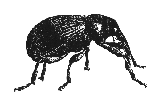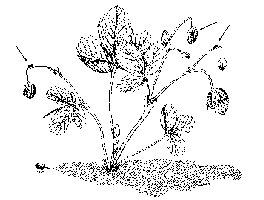Strawberry Clipper
Anthonomus signatus
Biology
The strawberry clipper, Anthonomus signatus,
also known as the strawberry weevil, is a dark, reddish-brown weevil
about 1/10 inch long; its head is prolonged to form a slender, curved
snout about 1/3 as long as the body. Adults overwinter primarily in
fence rows and wood lots (although a small portion of a population may
remain in the strawberry field), then move to plants with developing
fruit buds. The seasonal timing of strawberry flowering coincides with
clipper movement from overwintering sites, so strawberries are ideal
host plants for this insect.

Strawberry clipper (aka strawberry
weevil) Adult is 1/10 inch
(2.5 mm) long.
Damage
Adult clippers first feed on immature pollen by
puncturing nearly mature blossom buds with their snouts. The female then
deposits a single egg inside the bud and girdles the bud, preventing it
from opening and exposing the developing larva. The adult female then
clips the stem so that the bud hangs down or falls to the ground. Larvae
feed within the damaged bud for a period of 3 to 4 weeks; a new
generation of adults emerges in late June and July. These weevils feed
on the pollen of various flowers for a short time, but seek shelter in
midsummer in preparation for overwintering.

An illustration of the damage caused by
strawberry clippers early in the season
Control
Because the strawberry clipper does not disperse
over long distances, locating strawberry plantings away from wood lots
and hedge rows that harbor this insect through the winter reduces the
number of adults that move into strawberries in the spring. Because
earliest varieties are usually damaged more than later ones, planting 2
or 3 rows of an early variety as a trap crop around the perimeter of
each field has been suggested as a way to reduce overall damage or to
"concentrate" adults for control by use of an insecticide.
Integrated pest management guidelines for strawberries in Massachusetts (Cooley & Schloemann 1994) recommend sampling for strawberry clipper adults and damage as soon as flower trusses are visible in crowns. Look for clipped buds and adult weevils in unexpanded flower clusters. (This should be a close-up inspection -- hands-and-knees type of work.) Sampling should be most intensive along field edges near woods or hedge rows. One clipped bud per 2 ft. of row is enough to warrant an insecticide application for clipper control; limiting insecticide application to border rows may be adequate in many instances. If control is necessary, insecticides should be applied as soon as damage begins to occur, usually well before most flowers have begun to open. Check the most up-to-date edition of the Illinois Commercial Small Fruit and Grape Spray Guide for a listing of insecticides registered for clipper control.
References Cited
- Cooley, D.R., & S.G. Schloemann. 1994. "Integrated Pest Management for Strawberries in the Northeastern United States." Cooperative Extension Service, University of Massachusetts, Amherst.